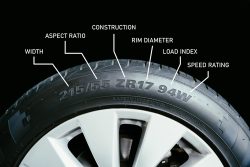Understanding Tire Ratings and What They Mean

1. Tire Size
The first set of numbers on your tire represents the tire size. It is typically displayed in the format of three numbers, followed by a slash, and then two more numbers. For example, 205/55R16. The first three numbers (205 in this example) represent the tire’s width in millimeters. The two numbers after the slash (55 in this case) indicate the aspect ratio, which is the ratio of the tire’s sidewall height to its width as a percentage. The final number (16 in this example) denotes the rim diameter in inches. By understanding the tire size, you can ensure that you are choosing a tire with the correct dimensions for your vehicle.
2. Load Index
The load index, represented by a number on the tire sidewall, indicates the maximum load capacity that a tire can handle. This rating is important as it ensures that the tire can support the weight of your vehicle and its occupants. The load index typically ranges from 71 to 110, with each number corresponding to a specific weight capacity. For example, a tire with a load index of 91 can support a maximum weight of 1,356 pounds. It is essential to choose tires with a load index that meets or exceeds the requirements specified by your vehicle’s manufacturer.
3. Speed Rating
The speed rating, also represented by a letter on the tire sidewall, indicates the maximum speed at which a tire can safely operate. This rating is crucial for ensuring that your tires can handle the expected speeds of your vehicle. The speed rating ranges from Q (99 mph) to Y (186 mph), with each letter corresponding to a specific speed. It is important to note that the speed rating represents the tire’s capability, and it is essential to always follow the speed limits set by the law and use safe driving practices.
4. Treadwear Rating
The treadwear rating provides an estimate of how long a tire can be expected to last based on a standardized test. It is represented by a three-digit number, where a higher number indicates a longer life expectancy. For example, a tire with a treadwear rating of 400 is expected to last twice as long as a tire with a rating of 200. However, it is essential to remember that the treadwear rating is a comparative measure and that actual mileage may vary depending on driving habits, road conditions, and maintenance practices.
5. Traction and Temperature Ratings
The traction rating indicates a tire’s ability to stop on wet surfaces and is represented by a letter (AA, A, B, C) on the sidewall. AA is the highest rating, indicating excellent traction, while C is the lowest. The temperature rating, also represented by a letter (A, B, C), indicates the tire’s resistance to heat and its ability to dissipate heat generated during extended driving. It is important to choose tires with good traction and temperature ratings to ensure optimal safety and performance on the road.
6. Winter Tire Ratings
For those living in regions with cold winters and snowy conditions, winter tire ratings become crucial. Winter tires are specifically designed to provide improved traction, handling, and braking performance in icy and snowy conditions. These tires are marked with a three-peaked mountain snowflake symbol, indicating their suitability for severe snow conditions. When choosing winter tires, it is important to look for the symbol and ensure that they meet or exceed the requirements for winter driving in your area.
Summary
Understanding tire ratings is essential to ensure that you select the right tires for your vehicle. By familiarizing yourself with the numbers and letters on your tire sidewall, you can make informed decisions about tire size, load capacity, maximum speed, treadwear, traction, and temperature ratings. This knowledge will help you choose tires that are suitable for your driving needs, ensuring optimal safety, performance, and durability on the road.
Need a Mechanic in Lubbock, TX?
Since 1975, M & M Tire and Service Center has been the premier provider of general automotive repairs in the Lubbock area. We are a family-owned and operated business with over 40 years of experience. Our friendly and professional staff work to provide quality repairs and services at reasonable prices. At M & M Tire and Service Center, we offer oil changes, brake servicing, suspension repair, tires, electrical system analysis, heating and air conditioning, engine repairs, doors and windows and safety inspections. Call us today to schedule your next appointment and see why the Better Business Bureau has given us an A+ rating since 1983.
More...
Categorised in: Tire Tips
This post was written by admin





